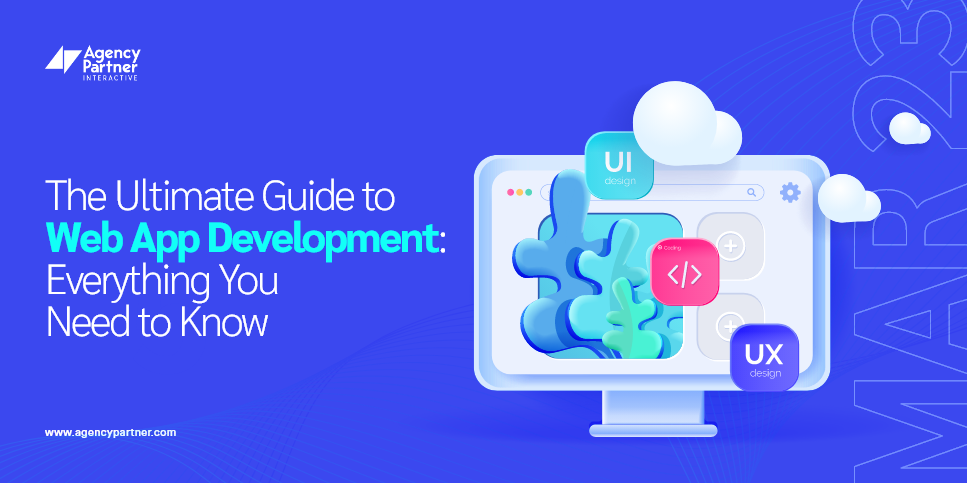
Digital Marketing
The Ultimate Guide to Web App Development
If you’re looking to create a web app but find the process discouraging or overwhelming, don’t worry! With the proper guidance and resources, it’s achievable.
The rewards of a well-built web app are significant. It can help your business grow faster, unlock new revenue streams, and improve customer experience.
This guide to web app development provides a one-stop resource for all you need to know. It includes all our blog articles on the topic. According to Statista, the global market size of web application development is projected to reach $13.9 billion by 2025.
Whether you’re a beginner just starting out or an experienced developer looking to learn new skills, we’ve got you covered. We will guide you through all the steps of creating a successful web app.
This includes selecting the correct web development platform and framework and optimizing the performance and user experience. Let’s dive in!
What is a Web Application?
A web application, or web app, is a software development service that runs on a web server. This type of program can be accessed through a web browser. Web apps are designed to be accessed by users on various devices, including desktops, laptops, tablets, and smartphones.
Web apps can be used for various purposes, including eCommerce, social media, productivity tools, online gaming, etc. Some examples of popular web applications include Facebook, Twitter, Google Docs, Trello, and Shopify.
Web apps are usually created with a blend of programming languages, including HTML, CSS, and JavaScript. Server-side technologies, like PHP, Python, Ruby, and Node.js, are also used. They are designed to provide a user-friendly interface and offer data storage, user authentication, and dynamic content generation functionality.
Web applications are essential to modern computing, offering businesses and individuals a powerful communication, collaboration, and productivity tool.
Why Build a Web App?
Web apps have many advantages. They are accessible, cost-effective, and reach a wider audience. They are also flexible, scalable, and easy to maintain. They can be accessed from anywhere with an internet connection and a web browser, making them highly accessible.
Web apps are often more cost-effective than developing and maintaining a native application for each platform. They can reach more people than native applications. They can also be updated and modified quickly without users needing to download and install updates. They are highly flexible, easily scaled to handle large amounts of traffic and data, and easy to maintain.
How To Build a Web App
Follow these seven steps to developing a high-quality web application. It should meet the needs of your target audience and give them a positive user experience.
Define the purpose and scope of your web application
Identify the problem your web app will solve and define the target audience. Determine the features and functionality required to meet the needs of your audience.
Choose the right technology stack
Choose the appropriate front-end and back-end technologies, frameworks, and programming languages based on your requirements and budget.
Create a design plan
Develop wireframes, prototypes, and mockups to visualize the design and functionality of your web application. Ensure your design is user-friendly, responsive, and aligned with your target audience’s preferences.
Develop the back end
Build the server side of your web apps, including the database, server-side programming, and business logic. Use the best coding, documentation, and testing practices to ensure scalability, security, and performance.
Develop the front end
Create the client side of your web application, including the user interface, user experience, and client-side scripting or programming. Ensure that your front-end design is consistent with your back-end design and aligned with your target audience’s preferences.
Integrate third-party APIs
Incorporate third-party APIs or services into your web app. Examples include payment gateways, social media APIs, and geolocation services. These services provide your web app with the functionality it needs.
Test and launch your web application
Test your web app thoroughly to ensure it functions correctly and debug any issues. Choose a hosting option, register your domain name, and deploy your web app to the server. Ensure your web app is optimized for performance and security before launching it.
How Much Will Web Application Development Cost?
Web application development costs can vary significantly depending on several factors. These include the complexity of the apps, the technology stack used, the location of the development team, and the development timeline. The software development company you work with also plays a major role in how much you can expect to pay for a quality web application.
The two main factors that influence the cost of web application development are:
The complexity of the web application
The more complex your web app is, the more time and effort it will take to develop, ultimately increasing the cost. The complexity of the application can be determined by the number of features, functionality, and integrations required.
Technology stack
The technology stack you choose for your web app can also impact the development cost. The cost can vary depending on the programming language, framework, and other tools. Some technologies may require more specialized developers, which can increase the cost.
Getting a more accurate estimate of your web app development cost is recommended. To do this, consult with a web development agency or freelancer. They can help you analyze your requirements and provide a more detailed cost estimate based on your needs.
Types Of Web Applications and How You Can Use Them
Here are some types of web applications and how they can be used:
ECommerce web applications
ECommerce web apps allow businesses to sell products or services online. Web applications can be used by retailers, wholesalers, and service-based businesses. They can use these apps to show their products and services. Furthermore, transactions can be processed online.
Social networking web applications
Social networking web apps allow users to connect with each other online. These web applications can be used for personal or professional networking or building online communities around shared interests.
Content management systems (CMS)
CMS web applications allow businesses to manage and publish digital content like blog posts, articles, and videos. These web apps are used by businesses of all sizes to create and manage their online presence.
Customer relationship management (CRM) web applications
CRM web apps are used by businesses to manage their interactions with customers, track leads, and automate sales processes. These web applications can help businesses streamline their sales and customer service operations.
Business process management (BPM) web applications
Business Process Management (BPM) web applications enable companies to automate and optimize their operations. Examples include human resources, financial, and supply chain management. These web apps can help businesses improve efficiency and reduce operational costs.
Educational web applications
Educational web applications allow educators to deliver online courses and training to students. Schools, universities, and businesses can use these web apps to provide ongoing education and training to their employees.
Potential Web Development Trends for 2023
There are many other web applications, and businesses can select the one that best suits their needs and requirements. By leveraging the power of web apps, businesses can reach a wider audience, streamline their operations, and drive growth and success.
Progressive web apps (PWAs)
PWAs are web apps that offer a native app-like experience, including features like offline functionality and push notifications. In 2023, we may see more businesses adopting PWAs as a cost-effective and efficient way to engage with customers.
Voice user interface (VUI)
Voice assistants like Siri, Alexa, and Google Assistant are gaining popularity. This is expected to result in a major shift in web development toward voice user interface (VUI) in 2023. This involves creating web apps that can be controlled using voice commands, allowing users to interact with the application hands-free.
Artificial intelligence (AI) and machine learning (ML)
AI and ML are already being adopted in many industries. Their use is also predicted to rise in web development.
By 2023, web applications may rely on AI and ML technologies to improve user experience. Automation of tasks will also be possible. Additionally, personalized recommendations could be provided.
Low-code/No-code development
Demand for web applications is rising. This creates a need for tools to assist developers. These tools should help them create apps quickly and efficiently.
Low-code and no-code development platforms are helpful for businesses. They enable developers to create web applications without writing code. This makes it simpler for businesses to develop and deploy apps quickly.
Cybersecurity
As cyber threats increase, cybersecurity will remain a top concern for businesses in 2023. Web developers must focus on creating secure applications that protect user data and prevent unauthorized access.
These are some potential web development trends that may emerge in 2023. However, it’s important to remember that technology constantly evolves, and new trends may emerge that we can’t predict now.
Key Takeaways for Successful Web Application Development
Web application development is a constantly evolving field that requires a solid understanding of programming languages, frameworks, and industry trends. Developing websites requires a systematic approach and using the latest tools and technologies. This is true whether the website is simple or complex.
Stay informed of the latest web development trends and best practices. This will enable you to create web apps that are user-friendly, efficient, and secure. They will fulfill the needs of your business and customers. Remember to prioritize planning, testing, and maintenance throughout the development process to ensure your web app is a success.
Let’s Build Your Future-Ready Web Application Together!
At Agency Partner Interactive, we create web applications with high standards. We make sure they are up to date with the latest web development trends. This ensures that our apps are future-proof. Our web app agency experts work with clients to understand their business needs.
We develop customized web dev services that meet these requirements. Our developers and designers collaborate closely on this process.
We offer a range of app development services to meet your needs, including
- Custom web application development
- Web design and UI/UX design
- Full-stack web development
- eCommerce development
- Mobile app development
- Web application testing and maintenance
Partner with us to build a scalable, user-friendly, and custom web app for your business to take it to the next level. Contact us today to get started!














